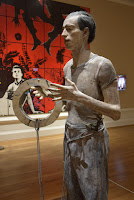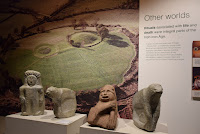We decided to spend our last morning in Belfast at the Ulster Museum. The fact that Museums in the UK have no entry fee is encouraging enough for Art lovers. We came across some rather unique and interesting photographs pertaining to the ongoing Photography exhibition right outside the main Museum entrance.




The first room in the Museum took us on a journey through Ireland and what its citizens had to go through to be "heard" and free (let's put it this way).

The Museum discovery journey continued with us immersing ourselves into a huge children's room with everything that might keep a child's curiosity "alive". I felt like a child myself, I must be honest. We soon embarked on a major journey very well supported by the information provided in the various rooms we "explored".



Every room we went into brought about a new dimension to my perception of Ireland and the world.




Alabaster Religious plaques - Examples of Italian Cinquecento or Renaissance work. Found at an Augustinian nunnery in the 1500s.
Agnus Dei reliquary - This golden reliquary, in the shape of a book contains five small compartments for holding the wax of Paschal candles blessed by the Pope. It has a depiction of Saint John Baptist on the cover and small suspension loops for attaching it to a gold chain.

Bronze Crucifixion plaque - 11th century

The room showcasing a series of black and white photographs dating back to the sixties - Conflicting Images - Photography during the Northern Irish troubles, caught our interest, which went beyond the historic aspect behind them.
Bill Kirk - Behind Boyne Square, Sandy Row. Featuring June Hutchinson sitting on a wall with her accordion.

Protest demonstrations - Rioter with catapult - Derry Londonderry 1981
We finally made it to the upper floors where there was a vast painting collection, we highly appreciated.

Cataract IV - 1967 Emulsion on canvas by Bridget Riley who in the 1960's pioneered a distinctive form of "op Art", a term used for paintings and sculptures which produce the optical illusion of movement.
Portrait of Daphne Spencer - A 1953 oil on canvas by Spencer. Spencer's skills as a portraitist is best known through a series of insightful self-portraits and the penetrating and affecting images he made of his close family. The sitter is the artist's niece.
Suspense - A 1916 oil on canvas by Walter Sickert, one of the most revered and influential British artists of the twentieth century. Sickert is best known for his uncompromising depictions of the squalor and disenchantment of Bohemian London.
Interior at Charleston - A 1918 oil on canvas by Duncan Grant. This interior view shows the painter Vanessa Bell painting a still-life and David Garnet translating Dostoevsky.
Resting - A 1905 oil on canvas by Sir William Orpen. A precocious painter and a brilliant draughtsman Orpen is siad to have been the most successful portraitist of his generation and a powerful war artist. The model used for Resting was one of Orpen's favourites, a young washerwoman called Lottie Stafford, who lived in a decrepit street.
We then made our way into a room displaying Abstraction and Figuration in 20th Century British Art.
Woman and child from the series of Invisible Cities - a 2015 lightjet print on fuji crystal paper mounted on alluminium by Paul Seawright. Seawright is said to have gained recognition in the 1990s for his forensic photographs of subjects associated with the effects and aftermath of Troubles in Northern Ireland. In 2005 his travels to Nigeria resulted in Invisible Cities, a series of austere and hauting photographs that convey the emptiness of human dislocation and the "invisible" consequences of war and terrorism in Sub-Saharan, post-colonial Africa.

Man with a ring - A 1975 sculpture, fibreglass, cloth and mixed media by John Davies. In the 1970's Davies produced arresting, life-size sculptures which have an unnerving physical presence. In Man with a ring Davies suggests the weight and muscular tension of the figure while alluding to a more spiritual presence. The use of blue paint could evoke veins or watery tides, but if this sets a somewhat pessimistic tone, the figure also holds a lifebuoy, symbolising the hope of rescue.
Sir John Lavery's exhibition room - "The artist as Thief- Lavery and Old Master Painting" (whose title is associated to Picasso's alleged remark about his own re-working of Old Masters' painting "good artists copy, great artists steal"), occupied most of our remaining time. I was taken by his production capacity, as well as his painting skills.
The greyhound, the British Legation, Tangier - A 1910 oil on canvas. By 1901, Lavery is said to have had a house and studio in Tangier and been closely involved with expatriate life there. The greyhound was painted in the drwing room of the British Legation and shows Sir Reginald Lister, the last Envoy and Lavery's daughter Eileen, dressed in a riding habit.

Edith Joseph - 1907 oil on canvas (left). During the 1900s many fashionable society ladies chose to dress in black to emphasise their pale complexions and rich jewellery. Lavery's portraits from this period oftern have a sense of theatricality, made possible by his subtle use of tones of dark brown and black. Alice - 1919 oil on board (right). Alice Trudeau was Hazel Lavery's only child and Lavery's step-daughter. Hazel 's first husband had died before her birth. This informal portrait study shows Alice reading in Lavery's Kensington studio.

Under the cherry tree - 1884 oil on canvas - Lavery painted Under the cherry tree on a village by the river Loing in South Paris, where artists used to gather since the 1860s. It is an early masterpiece and shows Lavery's interest in painting "en plein-air" or directly from nature.

The Mother - 1909 oil on canvas. Lavery is said to have sometimes re-worked his paintings turning them into portraits of his family. The Mother begun in 1909 originally depicted Lavery's friend and model Mary Auras. In 1924 Lavery re-painted it as a tender study of his daughter Eileen, holding her new-born child.
The lady in black (Mrs. Trevor) (left) - 1908 oil on canvas. Eileen in primrose yellow (right) - 1926 oil on canvas. Lavery's daughter Eileen posed for her father many times. In the 1920s Lavery is said to have largely abandoned his subdued colour harmonies used to dramatic effect and introduced a brighter palette more appropriate to the Jazz Age.
The wheighing Room, Hurst Park - 1924 oil on canvas. During the 1920s Lavery painted at Hurst Park, a racecourse in Surrey. The jockey on the scales is said to be Steve Donoghue.

The green coat (right) - 1926 oil on canvas. Hazel, the painter's wife is painted as Kathleen ni Houlihan, the personification of Ireland. The daylight raid - 7 July 1917 (left) - Oil on canvas. This painting records the afternoon of 7 July 1917 when German biplanes bombed London and were engaged by British aircraft. The dogfight was visible from John Lavery's studio window and is watched by his wife .

The bridge at Grez (left) - 1901 oil on canvas. This was probably painted quickly and in a single session. The figures are sketchily observed and the real subject seems to be the surface of the river, which recalls the Impressionists' fascination with the effects of light on water. Florida in winter. Florida in Winter (right) - 1927 oil on canvas. During the 1920s, the Laverys made several visits to Florida. The charm of this oil-sketch results from the contrast between the elegant figure of Hazel reading in the shade and the energetic quickly observed players on the sunlit tennis court.

Tangier Bay-Rain- 1910 oil on canvas. During the early 1900s Lavery spent long periods in Morocco drawn there by the dramatic North African landscape.
The walls of Marrakesh - 1920 oil on canvas.
Spring, the gardens, Villa Sylvia - 1921 oil on canvas.
We finally moved into a number of rooms displaying some fine Italian and Dutch painting exploring the use of light. Amongst those I was mesmerised by the Brueghels', I must confess before we walked into the last rooms exhibiting a collection of 20th century International Art.
Landscape with Windmills - oil on panel by Jan Brueghel the Elder, the son of the more famous painter Pieter Brueghel the Elder and brother of Pieter Brueghel the Younger.

Spring (left) and Winter (right) from the series of Four seasons - 1633 oil on panel by Pieter Brueghel the Younger.
Boy with a basket of vegetables - Oil on canvas by Giacomo Ceruti. Born in Milan Ceruti worked for a circle of wealthy and noble patrons in Venice, Milan and Brescia. Early in his career, Ceruti painted powerful and unsentimental images of beggars and the dispossed. Unlike Flemish painting, in which the peasants were often depicted as figures of amusement, Ceruti gave his beggars and pilgrims a sense of grave composure, suggesting dignity in poverty.
Le gouter au jardin - 1903 oil on canvas by Henri Le Sidaner. Born in Mauritius, Le Sidaner is best known for his small-scale paintings of figures in domestic settings or deserted streets in which the delicate depiction of light is paramount.
Seated female nude - 1921/22 oil on canvas by Mainie Jellett. The work shows a deliberate move away from figurative painting and marks an important stage in her progress towards abstraction.

Le village de Clans - Oil on canvas by Alfred Lombard. Lombard is loosely associated with the Fauves

Village in Italy - 1925 oil on canvas by Christopher Wood. Wood together with Ben Nicholson whom he shared his artistic interests with evolved a manner of painting that focused on simple shapes and abstract clarity.
Place du Tetre - 1949 oil on canvas by Daniel O' Neill. The candlelight at the café tables creates a sense of intimacy, however the empty windows beyond anticipate the sense of human isolation that would later dominate O' Neill's work.
Samoan scene - 1920 oil on canvas by Mary Swanzy. Swanzy studied in Paris and admired the work of Gauguin. In the 1920s she travelled to Honolulu and later Samoa, where she painted tropical landscapes in a style clearly influenced by the Fauves.
Overslept until the evening - 2014 oil on canvas by Makiko Kudo. Kudo's work is largely autobiographical and makes reference to the feelings of vulnerability and wonderment experienced during childhood. As with many of her generation, Kudo has been influenced by Japanese animated films, Manga comics and computer based technology.
This was undoubtedly one of the best moments spent in Belfast and certainly one to remember as we left Belfast on a flight bound to Southampton.

Photos taken from the Belfast terminal as we awaited our delayed flight back to Southampton.




























































Thank you so much for the museum tour, I enjoyed it immensely!
ReplyDelete